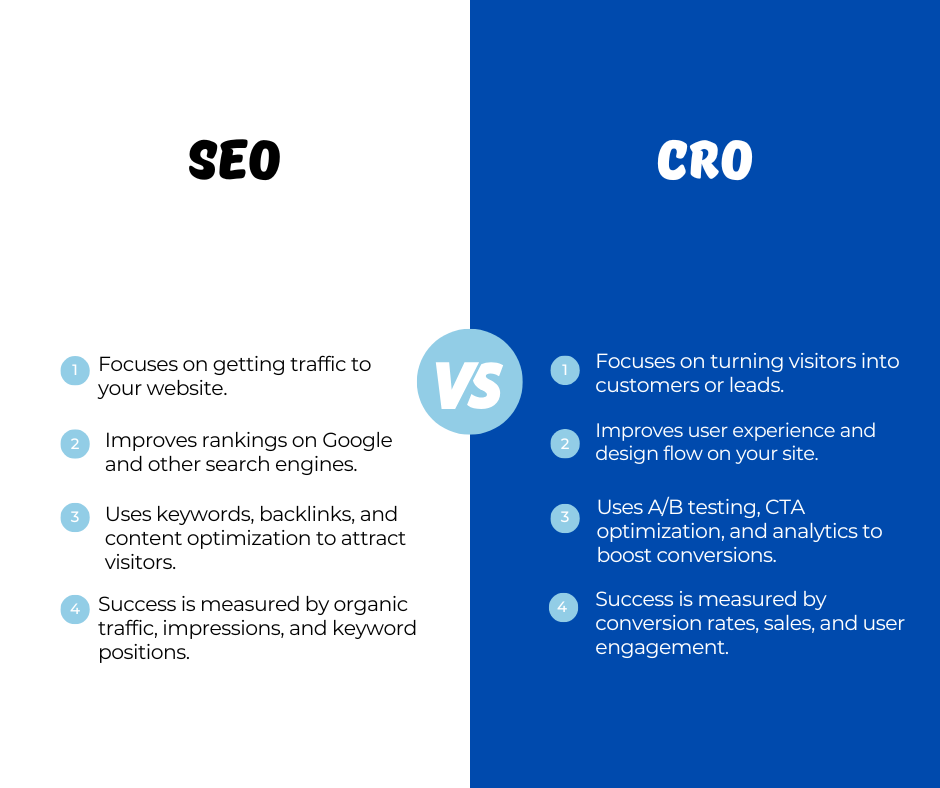When businesses want more customers, they often ask the same question:
Should we focus on SEO or CRO?
Some companies try to get more traffic through SEO (Search Engine Optimization).
Others focus on CRO (Conversion Rate Optimization) to turn more visitors into leads or clients.
But here’s the truth , you need both if you want real business growth.
SEO brings people to your website.
CRO makes sure those people take action.
Without SEO, your website has no visitors.
Without CRO, your visitors will leave without contacting you.
In this blog, we’ll explain the difference between CRO vs SEO, how each one works, and why combining them is the best strategy for B2B companies , especially IT service businesses like Arista Systems works with.
What is SEO?
SEO (Search Engine Optimization) is the process of improving your website so it appears higher in search results on Google and other search engines.
The goal of SEO is simple:
Attract more people to your website.
SEO involves things like:
- Using the right keywords
- Writing helpful and clear content
- Getting backlinks from trusted websites
- Improving page speed and website performance
- Making sure your website works on mobile
Why SEO matters:
When your website ranks high on Google, people find you naturally.
No ads. No pushy messages. They come because your business looks relevant and trustworthy.
68% of online experiences start with a search engine.
So, if your business is not showing up on Google, you are missing customers every day.
What is CRO?
CRO (Conversion Rate Optimization) is about what happens after someone arrives on your website. 22% of businesses are satisfied with their conversion rates, showing the need for CRO.
CRO improves your website so visitors:
- Fill out a contact form
- Book a call
- Request a proposal
- Download a case study
- Or take any meaningful action
In simple words, CRO turns visitors into leads.
CRO includes things like:
- Clear value message
- Strong call-to-action (CTA) buttons
- Simple and clean page layout
- Case studies and testimonials
- User-friendly design
Only 22% of businesses say they are happy with their conversion rates.
So, most websites are losing potential clients because they are confusing or unclear.
CRO vs SEO: The Key Difference
Here is the easiest way to think about it:
| SEO | CRO |
| Brings visitors to the website | Turns visitors into leads/customers |
| Focuses on visibility | Focuses on action |
| Long-term traffic growth | Better results from the traffic you already have |
| Helps you be discovered | Helps you get contacted |
Both are important.
One without the other means your marketing is incomplete.
Why You Should Not Choose One Over the Other
Some companies make a big mistake , they focus only on traffic.
They invest in SEO, and they get more visitors.
But conversions do not improve.
Why?
Because the website is not built to convert.
Then other companies focus only on CRO.
Their website looks great.
Their CTAs are strong.
Their messaging is clear.
But they don’t have enough traffic to convert.
This is like owning a beautiful store in the middle of an empty street.
You need both:
- Traffic (SEO)
- Action (CRO)
How SEO and CRO Work Together
Here’s how they support each other:
1. SEO Attracts the Right Audience
When your SEO strategy uses the right keywords, you attract people who are actually interested in your services.
2. CRO Helps Those People Understand Your Value
When your website is clear and easy to trust, visitors contact you instead of leaving.
3. Together, They Increase Lead Quality
You don’t just get more leads ,
You get better leads who are ready to talk.
Example: B2B IT Service Website
Imagine your website gets 2,000 visitors each month.
If your conversion rate is 1%, you only get 20 leads.
Now let’s say:
- SEO improves traffic to 4,000 visitors
- CRO improves conversion rate to 2%
Now you get 80 leads , 4x more leads without spending more per visitor.
This is how business growth actually happens.
Signs You Need SEO
- Your website is not ranking on Google
- Competitors show up before you
- Your website traffic is low
- You rely too much on paid ads
Signs You Need CRO
- You get visitors but few inquiries
- People bounce quickly from your pages
- Your messaging is unclear
- Forms are long and complicated
- Your website feels outdated

CRO Best Practices
- Use clear and simple messaging
- Add strong CTAs like “Book a Free Call”
- Show real client testimonials and case studies
- Make forms short , only ask what you need
- Ensure your site is fast and mobile-friendly
Stat: 88% of users don’t return after a bad website experience.
SEO Best Practices
To improve ranking:
- Write content that solves real problems
- Use the right keywords naturally
- Add relevant internal and external links
- Optimize page titles and meta descriptions
- Improve site speed for both mobile and desktop
Stat: A 1-second page load delay reduces conversions by 7%.
CRO vs SEO: Which Should You Start With?
If your website has no traffic, start with SEO.
If your website has traffic but no leads, start with CRO.
But the best answer is:
Start both , even if small , and grow gradually.
Conclusion
SEO and CRO are not enemies, they are partners working toward the same goal. SEO brings the right people to your website by improving your visibility and search rankings, while CRO makes sure those visitors clearly understand your value and feel confident enough to take action. If you rely only on SEO, you may get recognition but very few real leads. If you focus only on CRO, you may have a great website that no one ever discovers. But when SEO and CRO are used together, your website becomes both discoverable and conversion-ready, clear messaging, strong trust signals, smooth navigation, and results that actually matter. This combination is what leads to steady, meaningful business growth instead of random spikes in traffic or inquiries. It’s not just about getting clicks. It’s about turning interest into conversations, and conversations into partnerships.
Ready to find out what your website is missing?
Schedule a Free Website Growth Audit with Arista Systems.
We’ll review your SEO performance, your conversion flow, and your messaging alignment, and show you exactly where improvements can unlock more qualified leads.
FAQs
1. What is the difference between SEO and CRO?
SEO focuses on bringing more people to your website by improving your search rankings. CRO focuses on what those people do once they arrive, helping turn visitors into leads or customers. In simple words, SEO attracts traffic, while CRO helps convert that traffic into real business results.
2. What is the 80/20 rule for SEO?
The 80/20 rule in SEO says that 80% of your results come from 20% of your efforts. This means only a few key actions, like high-quality content, strong keywords, and relevant backlinks, create most of your growth. Instead of doing everything, focus on the tasks that matter most.
3. How does CRO relate to SEO?
CRO and SEO work together to grow your website’s performance. SEO helps you get the right audience to visit your pages, while CRO makes sure those visitors take meaningful action, like filling forms or calling your team. When combined, they create both visibility and conversions, making your marketing more effective.
4. How to combine SEO and CRO?
Start by bringing traffic through targeted keywords and helpful content (SEO). Then optimize your pages so visitors understand your value quickly and feel confident to act (CRO). Use clear messaging, strong CTAs, fast loading pages, and trust signals. Keep testing and improving both areas over time.


